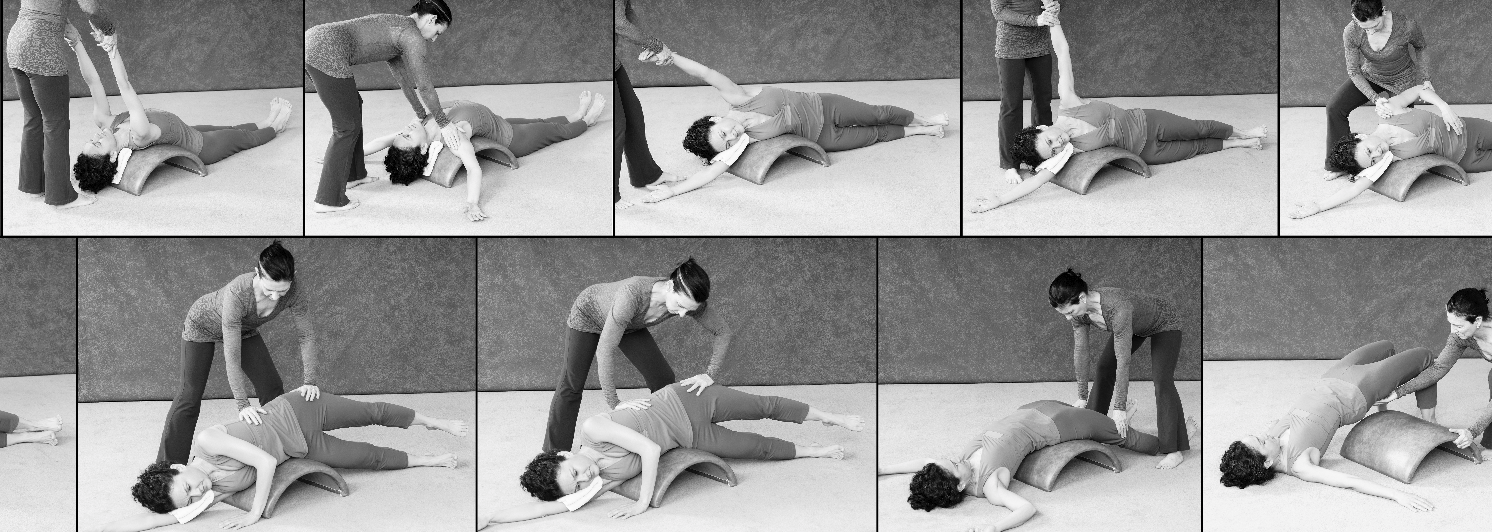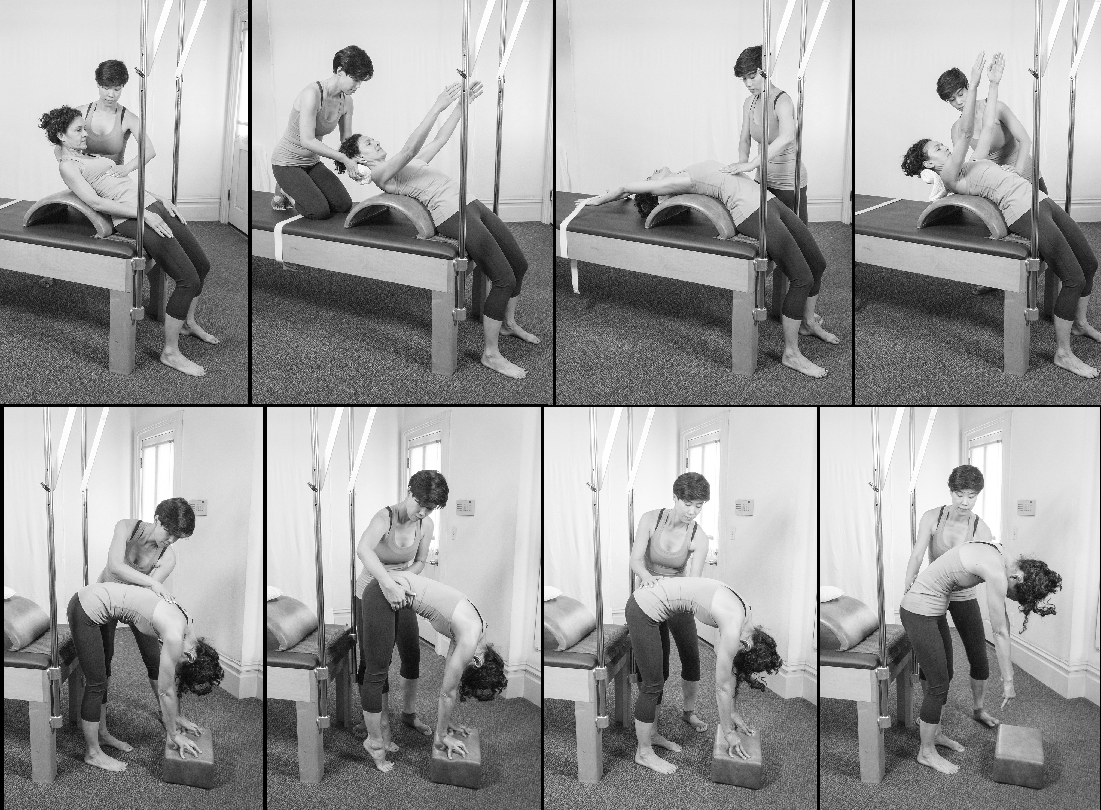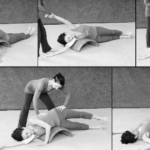Issue #336
Wednesday May 26, 2021
Extending or Extension: What are They and Do They Make a Difference?
by Suzanne Martin
Spinal extension makes us vertical people. Pilates sometimes gets a bad rap because its exercises seem too heavily swayed toward spinal flexion. Or are they? Joe Pilates did say, in writing, that he thought the spine bests forms into full flexion like it began in the womb. Too bad he is not around so we could argue with him, or from what I can tell about his personality without having met him, have him set us straight.
My quest, along with that of many other fine Pilates teachers, is to help my clients become stronger, happier, and more fit and, above all, to come to love Pilates as a tool to support the aging spine. Aging spines are notorious for falling forwards or sidewards. We’re here to help.
First off, let’s all acknowledge that the healthy spine (in verticality, in supine, in any position) alternates its regions between extension (AKA lordosis) and flexion (AKA kyphosis). Nature ingeniously gave us a vertical springboard in between the ground reaction force as we press away from the earth (by walking, running, or jumping) and the gravitational force, pulling us inexorably back toward the earth. Each region – the cervical, the thoracic, the lumbar, the sacral and the coccygeal – all optimally have a “normal” amount of both extension and flexion to constitute a basic functioning spine, the S-curve seen from the side or sagittal view.
It was recently brought to my attention that there is confusion about what this means for us as movement educators. We each have a genetic, individual S-curve shape in our spine. And this amount is “neutral” to us as individuals. Neutral is not a flat measurement of the spine. A truly flat spine is considered abnormal. Neutral is not the same as normal.
“Normal” is a statistical word meaning “average.” Yet every person is unique. We grow into our genetic and developed neutral lumbar spine lordosis, or extension. It is a static degree of the extension of lordosis. Yet the normal expected movement ability, from the individual’s static measurement is about 40-60 degrees moving into and out of extension. So the movement words of flexion, extension and lateral flexion indicate motion away from the person’s grown neutral measurement. The lumbar apex is generally considered best at L3, another varying characteristic. Similarly, the thoracic spine has a non-moving, developed in adolescence, expected degree range of kyphosis. It is only considered unusual when it is at its lowest of 0 and it considered difficult over 40 degrees when measured from a vertical internal plumbline. The apex of the thorax is generally considered best at T8.
What does all that measuring mean for me as a teacher? In teaching my classes on spinal asymmetry, first we seek to know fairly well what a generally typical spine looks and moves like to see the difference in a not-so-typical spine. Not all of us have access to x-ray measurements to definitively determine the lumbosacral angle, the pelvic incidence and absolute lumbar spine measure for each client to see if they are in the normal category. Nor do we need it all the time. Have heart. We can still do good.
Somehow our great guru, Pilates, knew that a healthy spine was both stable and mobile. Perhaps he would have benefitted from our current science and research, yet he was on the right track. One of the reasons I love Pilates is its ability to hyper-focus on the trunk and re-shape fascia along with organizing and strengthening the entire body. After studying for umpteen years about the pros and cons of spinal motion, I am 100% convinced that the spine needs continued reinforcement to maintain extension, that is, to stand up straight. The hallmark of aging is the insidious flexion that creeps up unnoticed for decades. After all, most of our daily life is done with forward bending, reaching activity. In later years, loss of lumbar extension is a critical element in the final ability to maintain the ability to walk. And for those of us with an asymmetrical spine, the Pisa effect looms large – yes, just like the Leaning Tower of Pisa.
What can I do? Here are a couple of my favorites. The first one is more passive and the next is more active.
First off, the use of the baby arc cannot be beat. I believe Pilates understood that the use of simple props, such as the arc, could help mold the torso by performing intentional breathing exercises on top. I developed a series that began most of my private sessions and that I now teach as a part of the youth program for spinal asymmetry. Here are some highlights, including Eve Gentry’s one lung breathing on top of the arc.

The next active one is the one I favor to end most of my private sessions. Once again, it uses the arc to release the spine. Then it trains the client to actively coordinate the anterior and posterior spine in a spinal roll up to vertical. This is where the magic happens. The client sees that while the back is extending, the front also counters the posterior force. Then bingo, deep front spine musculature lines (psoas and deep fascial frontal line) coordinate with multifidi and deep posterior lines to create the ultimate vertical stance, what we call elongation in our world. I’ve used this one to re-train dancers after spinal disc injuries. I hope you can use it too.

We help our clients in so many ways. Semantics need not be our nemesis. Please don’t shy away from extension. We need it in our lumbar and cervical spines for the rest of our lives.
I have faith in you.

Dr. Suzanne Martin has been practicing Pilates for over 30 years. She is a doctor of physical therapy, exercise physiologist and a gold-certified Pilates expert with a home studio in Alameda, California. An international presenter, she blends art and science, into her writing and instruction. She has been Lead Physical Therapist for over 20 years with Smuin Ballet. As founder of Pilates Therapeutics LLC she teaches worldwide on the subjects of spinal asymmetry, cancer restoration, foot management and performing arts enhancement. Look for her latest publication from Handspring Publishers, Spinal Asymmetry and Scoliosis; Movement and Function Solutions for the Spine, Ribcage, and Pelvis, available on the Pilates Therapeutics web site. For further information and to see her teaching schedule, go to www.pilatestherapeutics.com. It is never too late to be what you might have been. – George Eliot
The only sin is mediocrity. – Martha Graham

